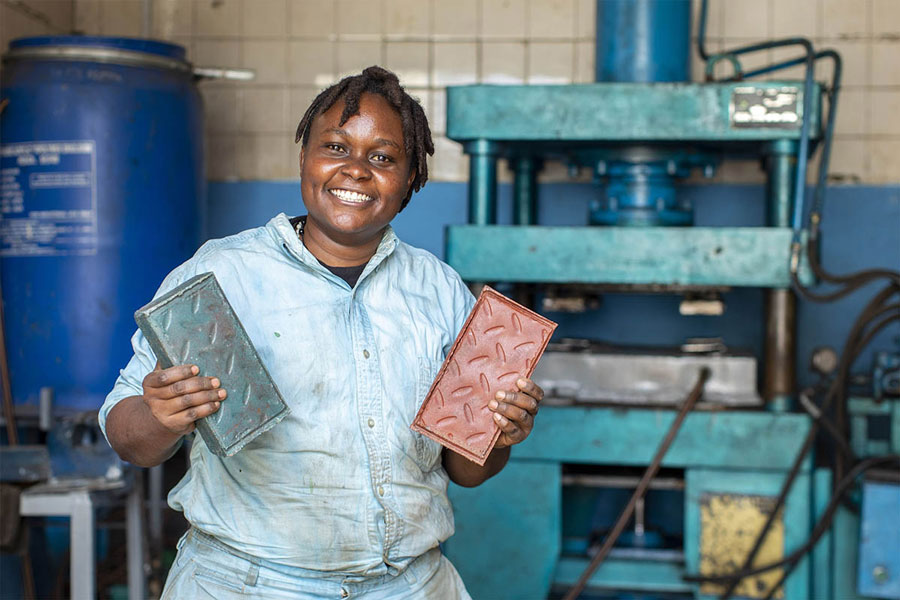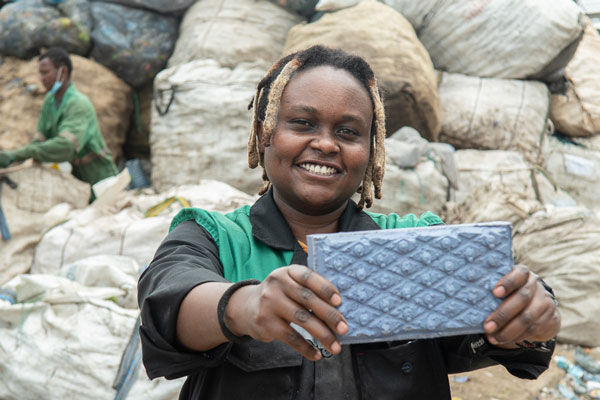Single-use plastic pollution is a global environmental threat, with 5 trillion plastic bags used per year and only a tiny percentage of them recycled. One engineer and her company are fighting back — transforming plastic waste into sustainable, alternative building products.
By Seabright McCabe, SWE Contributor
“You have to be true to your why,” Nzambi Matee says. “Why are you doing this? What is the motivation behind it? For me, I was tired of being on the sidelines, of seeing so much plastic waste.”
Matee is a materials engineer with a background in physics and a co-founder of Gjenge Makers Ltd., based in Nairobi, Kenya. It’s a city awash in discarded plastic — to the tune of 24 million single-use plastic bags discarded each month, not including plastic bottles and caps, and food and other plastic packaging and products. Some of it gets recycled, but too much litters the streets and waterways, endangers people and animals, and consumes landfill space.
Weary of bearing witness to plastic pollution, Matee decided to make something of it instead. She and a small team of engineers set about transforming unrecyclable plastics into something sustainable, socially and economically beneficial, and practical: plastic brick pavers.
“In Kenya, everything is practicality,” she said. “We needed a link into the construction and building space. The whole idea was to make something as practical and applicable to the society I live in, as much as I could.”
Four years from R&D to production
Matee sourced plastic for her pavers from two sources: post-industrial, the unrecyclable broken bits and offcuts discarded as products come off the factory lines, and post-consumer plastic waste, discarded products and packaging. “Occasionally, plastic packaging goes to a recycler where it is made into pellets to make more products,” Matee said, “but there is always some that cannot be recycled any further.”
Instead of those offcuts and fragments working their way into the soil, waterways, and the food chain, Matee sought to make them static — in the form of bricks that could be used to build something new.
Conquering formulation came next. Through testing, she and her team discovered that some plastics bind together better than others. Gjenge Makers settled on polypropylene plastic from microwaveable food packaging, bottle caps, and similar products, and polyethylene from plastic bags, trays, and containers. After winning a scholarship from an American social entrepreneurship program, Matee further refined her ratios of sand to plastic for the pavers at the University of Colorado Boulder.
Finding no production equipment designed for their specific needs, Matee’s team of four engineers designed and fabricated their own hydraulic press, which weighs in at 2–3 metric tons. Convinced that having figured out how to make one brick, the company could now make a thousand, she began knocking on doors, prototype paver in hand. “With some investors, we would just walk in and they would say no,” she said, in an interview with Capital FM Kenya. “Some would let us in, and listen — and then say no. I successfully got 52 no’s over a period of about eight months.
“Human beings are everything, and I have a really strong, capable team,” she said. “They can do wonders. All they needed was the opportunity. Just one person to say yes.”
Stronger, lighter, cheaper than cement
Concrete bricks are made from sand, ballast, cement, and water, a heavy mixture. Gjenge’s bricks combine plastic particles with sand, instead of using cement as the binding agent. The plastic as a fibrous binding material gives the brick more structural strength, making it far less brittle, with fewer air pockets and greater compression strength than traditional bricks. Five to seven times stronger at half the weight than concrete and made of cheap materials, they are less costly to make and transport, and quicker to install.
First, sand and shredded plastic are mixed with pigment and shoveled into an extruder, which further mixes under temperatures of about 680˚F (360˚C). Workers in heavy protective gloves cut and weigh the extruded product, then place it in a set of molds where it’s pressed with a weight of 100–200 metric tons. Once pressed, the bricks cool for a few minutes, then sit in a water bath until cool enough to handle, stack, and transport. The pavers come in two widths — one for foot traffic and light vehicles, the other for car and bus traffic — and multiple colors. They have a melting point of over 660˚F (350°C) and feel like walking or riding on a rubber surface.
Gjenge Makers introduced its pavers into the local markets of Nairobi in 2020. By March 2021, the company had transformed 20 metric tons of previously unusable plastic scrap into pavers for sidewalks, footpaths, and driveways. Schools and homeowners are clamoring for more, and the company expects that number to more than double within the year.
Pavers today, construction tomorrow
Gjenge Makers partners with manufacturers of plastic bottle tops and seals in the beverage and pharmaceutical industries. “Informal waste collectors deliver to us, which we jointly use to produce the pavers, while providing them with a stable income,” the company’s website states. “We have financially empowered over 112 individuals, the majority of whom are women and youth groups.”
Currently, Gjenge Makers recycles 1,100 pounds (500 kilograms) of plastic waste per day. Ramping up production 5,000 bricks per day from the current 1,500 is the next big challenge. Matee also hopes to begin diversifying her product line to construction products for much-needed housing and is seeking funding to scale up the solution, not just for Kenya but worldwide, to “inspire and impact other youth to do different and similar things in their societies.”
In 2020, Matee was named a Young Champion of the Earth by the United Nations Environment Programme (UNEP), which provides seed funding and mentorship to promising environmentalists. Reflecting on her entrepreneurial journey in a UNEP video, she said, “It was like I jumped off a cliff without even a parachute. I was building this idea as I was falling down. Isn’t that how great things are done?”
Innovations to Make Repurposing Plastic Waste More Viable
According to the United Nations Environment Programme, more than 8.3 billion metric tons of plastic has been produced since the early 1950s. Of this, only about 9% has been recycled, with about 12% incinerated and the remaining 79% winding up in landfills or the natural environment. Alongside Gjenge Makers’ sustainable pavers, other innovations are pushing to solve plastic pollution, while reducing energy consumption and costs for industries and consumers.
Polyethylene fabric
A team in the Massachusetts Institute of Technology department of mechanical engineering recently developed a breathable, stain-resistant, and fully recyclable fabric from single-use plastic bags. The fabric is less expensive to produce and care for than polyester, nylon, and cotton, and could reduce energy and water consumption for both the textile industry and consumers. Svetlana Boriskina, Ph.D., lead author of a paper on the project, said, “If you can make polyethylene into a sneaker or a hoodie, it would make economic sense to pick up these bags and recycle them.”
The recyclability of MIT’s fabric may present us with a closed loop of reuse — a way to keep discards out of landfills, where they can slowly degrade and become a problem.
Graphene from plastic
A team at Rice University has developed a way to turn plastic waste into graphene in seconds, through flash joule heating, a low-cost, efficient process that superheats plastic powder (1–2 millimeter pellets) by running current through it, then rapidly cooling it to produce single-layer graphite, or graphene, for use in cement, polymers, and asphalt roads. A startup company, Universal Matter Inc., is working to scale up the process to the industrial level, estimating the cost of conversion at $125 per ton of plastic waste, and eliminating the need for resource-intensive graphite mining and processing.




